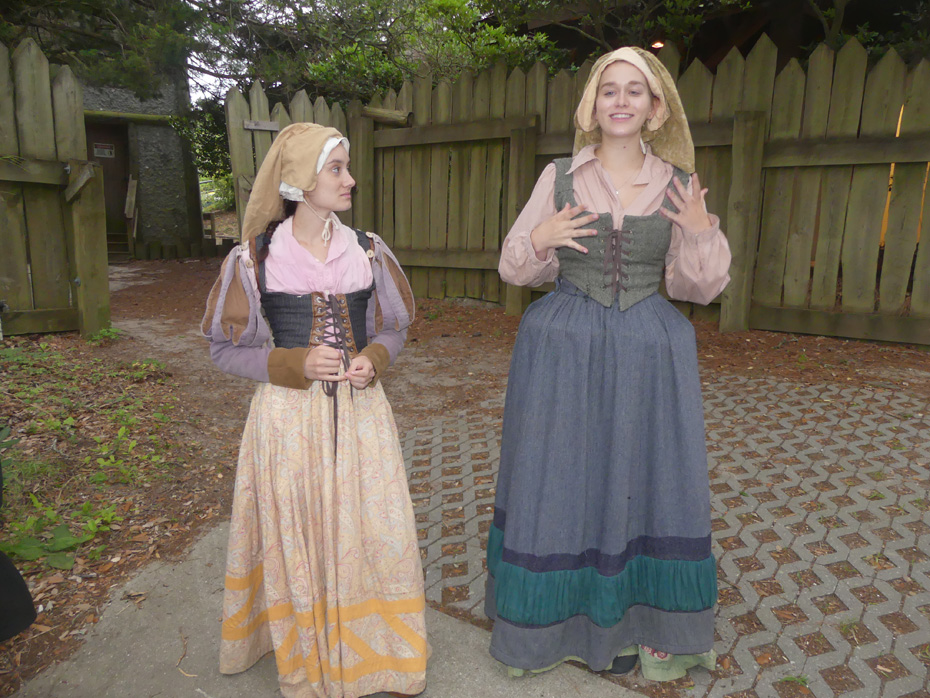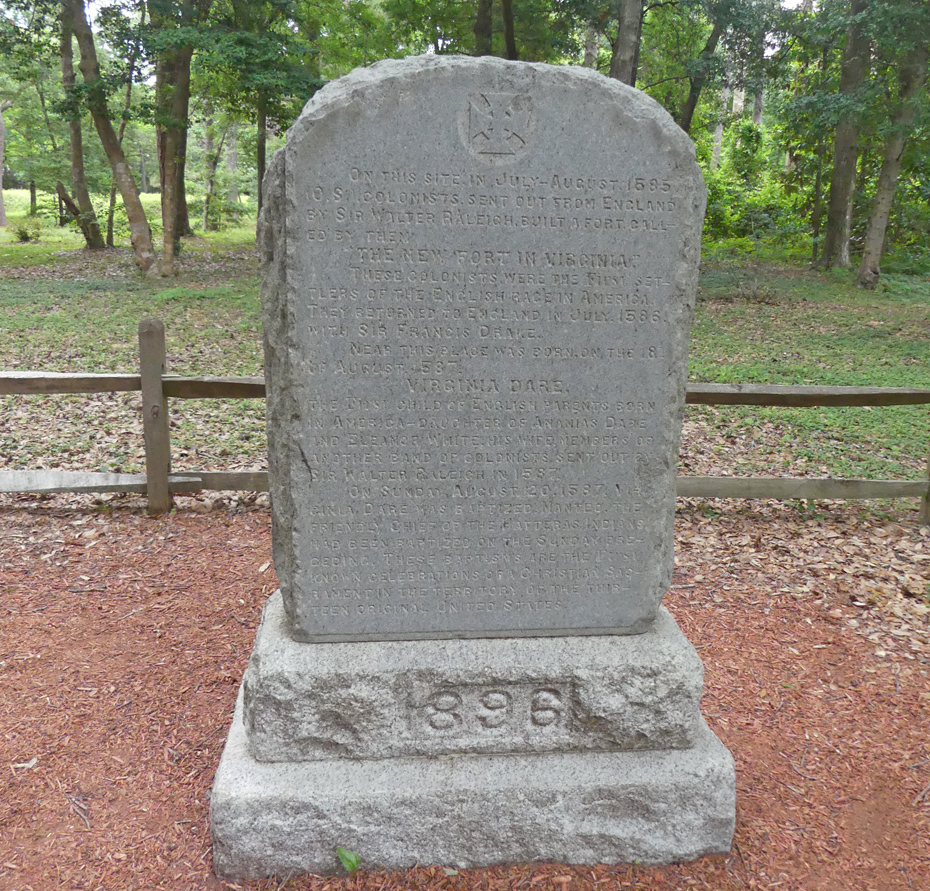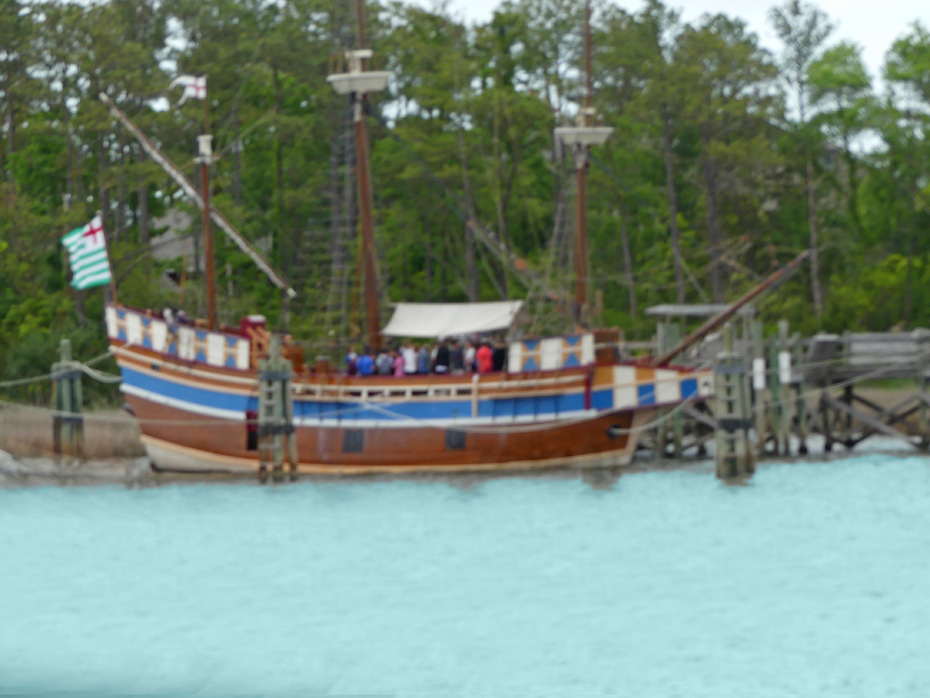
American's oldest mystery has
never been solved. I loved visiting the
Outer Banks to
learn more about the story. The story began with the
settlement of Roanoke in the Outer Banks of North
Carolina. The prelude was the earlier all-male
expeditions. The first led by Arthur Barlowe and Philip
Amadas, in 1584 was more of an exploratory one. One
thing they did had a profound effect on the final settlement;
they brought two young natives, Manteo and Wanchese,
back to England.

The second
expedition in 1584 was led by Ralph Lane and Sir Richard
Grenville. This ended in disaster when Lane accused a
Native Secotan chief of stealing a silver cup and killed
him. Not a smart move as the settlers were dependent on
the native's good will. The survivors
returned to England with Sir Francis Drake. He was
either a pirate or
privateer depending on whether you were Spanish or
English.


The main act began in 1587 when
a group of 117 (That figure varies between 115 and 120
depending on the source) English men, women and children
settled the area. John
White was governor and the settlers brought with them
two natives who had visited England with the first
returning expedition.

Naturally politics played a big
hand in affairs then as it still does. Spain had already
established a colony in Saint Augustine and had driven the French colonists
out of Fort Caroline that would become present day Jacksonville.
England wanted her share. Elizabeth I gave
Sir Walter Raleigh the right to settle a colony in the New
World and claim it for England.
The Lost Colony
A visit to the Outer Banks
offerd me ample opportunity to view that story. There is
the award winning play,
The Lost Colony,
which offers a somewhat factual portrayal of what might
have happened and Fort Raleigh National Historic Site
which preserves historical facts. Several places around
the area put you in the mood. ThThe
Elizabethan Gardens lets you experience a typical
Elizabethan garden of the time. Roanoke Island Festival
Park recreated the experience of the colonists and more.
The First Colony Inn
is the place to stay here.

The Lost Colony
tells the story in song, dance and action at
Waterside Theater, an outdoor theater located on
Albemarle Sound where the settlers anchored their ship.
A good way to really get into the feel of things is to
take the backstage tour before the play begins. You are
greeted at the gate by two of the "settlers."
The night I attended, Emma and Olivia were the
guides. This lets you see scenery being prepared and
costumes readied.

The play was written by Pulitzer
winning author Paul Green, and performed since 1937, is the longest running outdoor drama in the
country. It's won a 2013 Tony Honor for Excellence and
is the only outdoor theater to receive that honor. The
stage has three areas and begins with the narrator
setting the scene on a side stage. Then the main stage
comes to life with the Native Algonquians meeting
Europeans for the first time.

The play progresses through the
earlier expeditions and the political maneuvering in the
queen's court in England. Sir Walter Raleigh flattering
the queen telling her the new land was named "Virginia"
in honor of her, "The Virgin Queen."

The play portrays the birth of
Elyoner's child, Virginia Dare. Things grew difficult
for the colonist. Of the two natives who had gone to
England, their reactions were opposites. Mateo believes
cooperation with the settlers is the only way to go.
Wanchese sees the English as a threat and believes they
will exterminate his people. Conflicts
arise. Food was scarce and so John White agreed to
return to England for supplies. Unfortunately, by
the time he arrives, war has broken out with Spain.
Queen Elizabeth refuses to allow any ships to leave as
all are needed to fight Spain.
It is three years later before
Governor White returns to Roanoke. There he finds the
site abandoned and the letters CRO carved on a tree. He
takes this to mean they have gone to live with a
friendly tribe at modern day Buxton. A storm prevents
him and his men from searching there. The ship sailed
back toto England and he never returned to
America.
The Lost Colony
stays pretty true to historical fact until the last act
when no one today knows the actual ending. In the play,
Spanish ships are sighted and the settlers plan a move
to another place.
Fort Raleigh
National Historic Site
Fort Raleigh
National Historic Site is a way to explore the facts
of the lost colonists. The Waterside Theater is on the
grounds of the historical site.
Stop in the museum first and
catch a ranger explaining what is historically known.
The museum is filled with exhibits of native pottery and
artifacts. One particularly interesting display board
offers the possible explains and the reasons for and
against each possibility. Natural causes: could have
been a hurricane, starvation or disease. They could have
been attacked by either natives or Spaniards. The most
commonly believed theory was that they left of their own
accord because of any number of rreasons such as
invading Spaniards or the natives becoming more hostile
there. If that is the case--and it is bolstered by the
fact the settlers left the word CRO carved on a tree and
CROATIAN on a post as instructed by John White when he
left to return to England for supplies—what happened
next?

Coroatian was the name of an
island nearby and the friendly tribe who lived there.
The settlers could have gone farther inland or even to
the Chesapeake Bay. Did they become assimilated into the
natives' culture? There is some evidence of that but
nothing conclusive.

On the grounds there are some
must-sees. An 1896 Memorial Marker commemorates the
first settlers. It is carved with information including
the date the fort was built, July- August 1585, and
named simply "The New Fort in Virginia." It commemorates
the birth of Virginia Dare on August 18, 1587 to Elyoner
White Dare and Ananias Dare.
It notes the date of Virginia
Dare's baptism, August 20, 1587, and the baptism of
Manteo the preceding Sunday.
It is careful in its wording, "These baptisms are the
first known celebrations of a Christian sacrament in the
territory of the first thirteen original United States."
Saint Augustine being a Catholic Spanish colony had
several sacraments celebrated earlier.

One of the most impressive
structures at For Raleigh National Historic Site is the
reconstruction of the earthworks created by Ralph Lane
and the members of the second expedition. So far no one
knows what the earthwork was used for as it was too
small for even the few men in that group let alone for
the later 117 colonists. They do know it was a typical
earthworks built by digging a ditch and using the
removed earth to build walls around it./p>
Strolling the Thomas Hariot
Nature Trail out to Albemarle Sound, you realize you are
walking where these first colonists walked. It's an
awesome feeling.
The Elizabethan
Gardens
The Elizabethan
Gardens place you in a traditional English garden
such as Queen Elizabeth and Sir Walter Raleigh would
have been accustomed to.
The flowers range from giant hydrangeas to colorful
lilies and everything between.

It also has the largest stature
of Elizabeth I in the country.
If you're lucky you may meet the
resident cat, Momma, back near the greenhouse. The
gardener I met there told me about the year one of the
garden workers was also in the play. The cat had become
so attached to the young man. It often followed him back
to the theater. One night it wandered on stage with him.
The cast just proceeded as if that was part of the show.
Roanoke Island
Festival Park
Roanoke Island
Festival Park is an interactive family attraction
that offers you a simulated experience of the first
English settlement in America. The park’s centerpiece is
the Elizabeth II, built to resemble one of seven English
ships that made the voyage in 1585. There are recreated
native villages and a recreated colony, with costumed
interpreters. It's a living history lesson.

Lost Colony Inn
Lost Colony Inn
is the perfect place to stay for your visit. It's
located just across the bridge on Nags Head. My
suite was named for Margaret Lawrence, Elyoner Dare's
maidservant.

One of the other rooms was named
for a special woman, Margery Harvie. This was the other
woman who bore a child in the lost colony a short time
after Virginia Dare.
The Inn is
featured here .
Public Disclosure
Please Read
FTC has a law
requiring web sites to let their readers know if any of the
stories are "sponsored" or compensated. We also are to
let readers know if any of our links are ads. Most are not.
They are just a way to direct you to more information
about the article where the link is placed. We have several ads
on our pages. They are clearly marked as ads. I think
readers are smart enough to know an ad when they see one but to
obey the letter of the law, I am putting this statement here to
make sure everyone understands. American Roads and Global
Highways may contain affiliate links or ads. Further, as their
bios show, most of the feature writers are professional travel
writers. As such we are frequently invited on press trips, also
called fam trips. On these trips most of our lodging, dining,
admissions fees and often plane fare are covered by the city or
firm hosting the trip. It is an opportunity to visit places we
might not otherwise be able to visit. However, no one tells us
what to write about those places. All opinions are 100% those
of the author of that feature column.
| 


